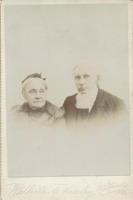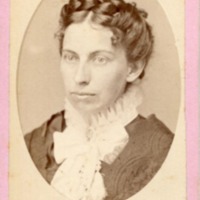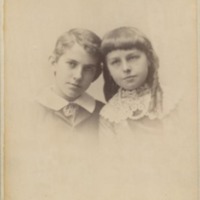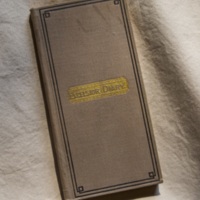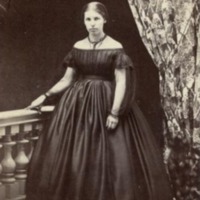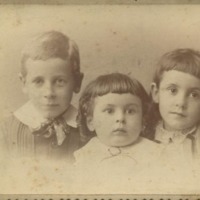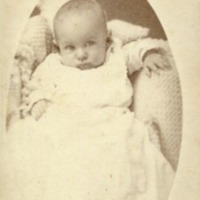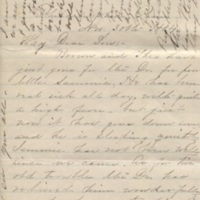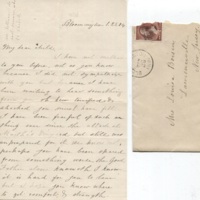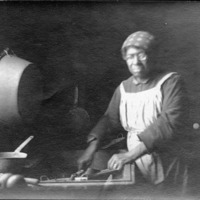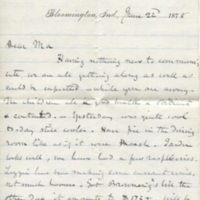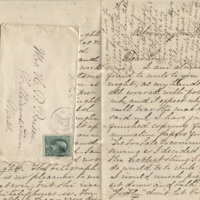The Dining Room: Introducing the Wylie Women
Three Wylie Women: A Generation of Late Nineteenth-Century Mothers
As you explore the exhibit, click on images to learn more about the artifacts and to read full transcriptions and view full-size scans of the letters.
The tour continues to the dining room of the Wylie House, a space of gathering. In this multi-purpose room, the family would have shared meals, study, and leisure. However, these activities extended beyond the family, as the space was used alongside student boarders and visitors. The presence of boarders, paying for the domestic labor of mothers, contradicts women’s advice that promoted selfless work for the good of the home and family. The intermingling of family and outsiders further defines the home as both public and private, complicating the ideal of the “woman’s sphere” yet again.
The Theophilus and Rebecca Wylie Family
In 1859, the family of Theophilus and Rebecca Wylie moved into the Wylie House. Among other roles, Dr. Wylie was a college professor at Indiana University and a Presbyterian minister (For more information on the professional life of Theophilus A. Wylie view the Wylie House's online exhibit, Leadership at Indiana University: Andrew and Theophilus Wylie, 1820-1890.) The couple had eight children, six of whom lived to adulthood. Theophilus died on June 9, 1895. Rebecca continued to live at the house until June 11, 1914, when she passed at the age of 101. The exhibit focuses on the couple’s two eldest daughters, Margaret and Louisa, and daughter-in-law, Seabrook. These women's families represent the continuation of the Wylies as none of Theophilus and Rebecca's other children had children of their own.
Elizabeth Louisa Wylie Boisen
The eldest child of Rebecca and Theophilus Wylie, Louisa Wylie was born in October, 1839 in Bloomington, Indiana. She spent much her early life as a devoted student and graduated with a Bachelor of Science degree from Indiana University in 1871. Her educated upbringing led her to pursue a teaching career before eventually marrying and raising children. She taught mathematics and modern language at the University of Missouri from 1872 to 1873. Especially interested in botany, an enthusiasm she shared with her husband, Louisa’s letters are often filled with references to her gardens or the flowers around her home.
Louisa met Hermann B. Boisen as a faculty member of the university, boarding at her parent’s home, the Wylie House. They married in the summer of 1873, at which time Louisa was thirty-three years old. With him, she had two children, Anton (born in the Wylie House in 1876) and Marie (also born at the Wylie House in 1879). Throughout the years of Louisa’s turbulent marriage, she often returned to her parent’s home for support and loving company. In an 1894 autobiographical statement, Louisa wrote, “Her husband was a skilled and enthusiastic botanist and together they studied the habits of plants, their successful growth and most effective management. After ten years of married life, the beloved husband and father, the lamented teacher, was suddenly taken away by death at the beginning of a most congenial work in the Boys’ School at Lawrenceville, N.J. and the bereaved wife returned with her two little children to her father’s house in Bloomington.” Hermann died suddenly in 1884 of heart failure. Without a means of independently supporting herself or her children, Louisa returned to the Wylie House with Anton and Marie.
As a large portion of the Wylie House collection comes from descendants of Louisa, many of the letters relate directly or indirectly to her experiences. Because of this, Louisa’s voice stands out comparatively to the other women. Likewise, her experiences recurrently led her back to the Wylie House, grounding her as central figure within the Three Wylie Women narrative.
Margaret Wylie Mellette
Margaret, often called Maggie in the letters between family and friends, was the second daughter of Theophilus and Rebbeca Wylie, born on August 6, 1843. She attended the Monroe County Female Seminary and the Glendale Female College near Cincinnati. Before marriage, Maggie wrote in her diary of her dreams of studying art in New York or Philadelphia. Though she never did, as a self-taught artist she completed several oil paintings and other projects, one being the decorated teacup and saucer, a Christmas gift for her sister, Louisa, and Louisa’s daughter, Marie.
At the age of twenty-two, Maggie married Arthur Calvin Mellette who boarded at Wylie House while attending Indiana University. They were married at the Wylie House in May of 1866 and then settled in Muncie, Indiana, where Arthur practiced law and edited the local newspaper. Here, they had four sons, Theophilus Wylie (May 16, 1867), Charles Edmond (March 1, 1869), Arthur Anton (February 6, 1872), and Joshua Richard (October 1, 1874). In 1878, the Mellettes moved to the Dakota Territory, in part because Arthur thought the western climate might benefit Maggie’s poor health. Arthur was elected Governor of the South Dakota Territory in 1889 and then the first governor of the state that same year, making Maggie the first “First Lady”.
Today, the Mellette House, the family home built in Watertown, South Dakota, stands as a monument and museum of South Dakota history. Much of the information about Maggie’s experience as a woman and mother comes from the research done at this historic house museum. Because of this, and because of Maggie’s published diary entries, her experiences and desires of individual and motherly fulfillment, at times, vividly take form and allow for intimate entry into the life of the late nineteenth-century mother.
Sarah Seabrook Mitchell Wylie
Sarah Seabrook Mitchell, affectionately referred to as Sedie or Sede, was born in 1857 in Texas. By 1870, Seabrook was living with George and Harriet Hoss, her aunt and uncle, in Bloomington, Indiana. Here she met Samuel Brown Wylie or Brown, whom she married in 1877 at the age of twenty. From the time of their marriage until 1885, the couple lived in the Wylie House with Theophilus and Rebecca, and a number of in-and-out relatives and boarders. During this period, the couple had three children, Theophilus (or Theo) Andrew (March 10, 1878), Samuel Brown Wylie (March 2, 1882), and Rebecca (or Reba) (September 21, 1884). In 1885, the couple set up housekeeping nearby on North Walnut Street. During her years in Bloomington, letters to and from Seabrook are sparse, and therefore her early mothering experiences are less realized within the historical record.
In 1888, the couple moved to Beaver Falls, Pennsylvania, where Lawrence Seabrook (May 17, 1887) was born. Here, the Wylie family experienced financial instability. Seeing herself as a major cause of the couple’s debt, in 1890, Seabrook found employment “overseeing the domestic parts” of St. Luke’s School in Bustleton, Pennsylvania. On May 8th, 1890, she wrote, “My plan would be to take Theo and place him in this school, and there do some good for him, work for our board and his tuition. Thus our living expenses would be all cut off.” The rest of family returned to Bloomington, so that the younger children could be cared for by their grandmother, while her husband looked for work. However, shortly after returning to Bloomington, Brown died of Bright’s disease. Seabrook continued to work away from her children, but in Boston, again, taking only her eldest son, Theo. There she found employment at the first Young Women’s Christian Association in 1892. Though her financial problems improved marginally, Seabrook continued to struggle emotionally, and her honest and frank letters reveal a deep desire to reunite with her children and her personal identity as a mother.
Extended Mothers: The Many “Mothers” of the Wylie Children
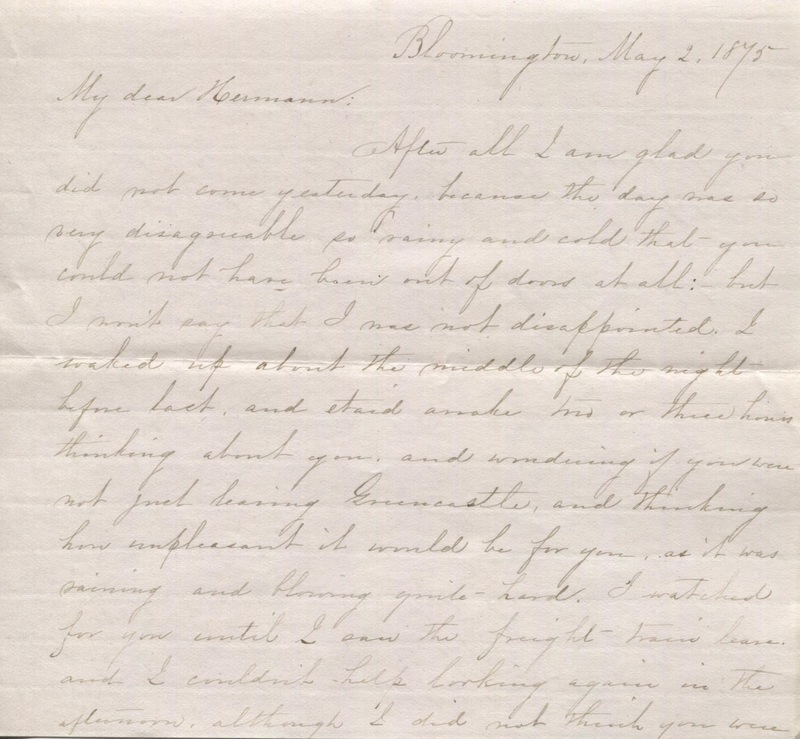
"It seems as if this dear little child brings us all closer together. It belongs to us all.” - Louisa Wylie Boisen, May 2, 1875
The three mother’s reliance on their familial, female relations to share the emotions and tasks of childrearing exemplifies the strong, emotional bonds between women at this time, while also indicating a departure from a maternal ideal that situated the biological mother as the sole moral educator and caretaker of her children. “Extended mothering” serves as an important thread between the maternal lives of the Wylie women. Like many women of their time, Louisa, Maggie, and Seabrook relied on one another and the support of a larger circle of female family and friends to fulfill their maternal responsibilities. A letter from an expectant Louisa to her husband, Hermann, on May 2, 1875 exemplifies these feelings of shared mothering. She wrote,
“It seems as if this dear little child brings us all closer together. It belongs to us all.”
Examples of “extended mothers” and motherly support appear throughout the family letters, as women write to one another seeking assistance, advice, friendship, and understanding.
Rebecca Dennis Wylie
As the matriarch of the Wylie family and a maternal figure to many of her grandchildren, Rebecca exemplifies "extended mothering." Family letters written to or from her attest to her devotion and busy life as a mother of many. Throughout their adult years, the daughters and daughter-in-law of Rebecca Wylie often called on her to advise or assist with their own needs and the needs of their children. On November 30, 1884, Seabrook wrote of Rebecca to Louisa, “Give Mother my best love. I so often wish to talk to her. I feel many things she told me I have found true.”
On several occasions, the grown children of Rebecca and their children returned to her, staying at the Wylie house for extended periods. Rebecca was often described in letters as constantly sewing, cooking, gardening, caring for the sick, and lovingly tending to her ten grandchildren. Just one example of her motherly care, Rebecca often looked after Maggie’s son, Anton, when his mother was too sick to care for him – sometimes for months at a time. On November 9, 1874, Rebecca wrote to Louisa of her beloved Anton:
“I have been deliberating all evening, which was the better, to write to you or sit down and finish an apron for Anton, and at last concluded to write to you and let the apron go unfinished. . . I have only written once to Maggie and I know she is anxious to hear how Anton is getting along. He seems pretty well now, but he was so petted on me that he would go to no one else, would not sleep with Aunt Em or scarcely speak to her.”
Susan Emma Dennis, “Aunt Emma”
Susan Emma Dennis or “Aunt Emma”, the younger, unwed sister of Rebecca Wylie, lived with the family at the Wylie House from 1872 to 1876, at which time both Maggie and Louisa were occasionally staying at the home with their children. Emma’s diaries, which mostly serve to record to her everyday routine and chores, allow for a glimpse into the mundanity of motherly duties and endless responsibilities of domestic life. Relatable to most, she frequently wrote complaining of wash day, especially when little visitors were staying at the home. Her letters during this time also noted many of her domestic and extended-motherly duties. On August 18, 1873, she wrote to Louisa:
“So I acted as mother to the two little ones until last Wednesday. . . two better children than baby and Charley [Maggie’s children] one does not often meet. Charley said before he left, “I want some of you to come to Muncie.” Here I replied you will have your wish for Grandpa and Brown are both going. “Well,” said he, “but I want some of you women folks to come. Grandma and you and Lizzie when she can.”
Elizabeth Breckenridge
Elizabeth Breckenridge, or “Lizzie,” as she was known by the Wylie family, worked from the age of thirteen to sixty-seven, as a domestic servant for the Theophilus and Rebecca Wylie family. Her length of duty with the Wylies as a paid domestic was unusual for the time. Likewise, as one of few black Bloomingtonians, Elizabeth’s role as an extended mother within in a white Middle-class family should be understood as significant and atypical. Through her many years of housekeeping and childcare at the Wylie House, Elizabeth developed a maternal role within the family, as a caretaker of Louisa, Maggie, and Seabrook’s children. A physical example of her close relationship with the children, her photo, notably taken from a low angle, is believed to have been done by Laurence Wylie, Seabrook’s youngest child. Another example, on June 22, 1878, Theophilus Wylie wrote, “Lou has been preserving, is jellying. The boys have staid with us nearly the whole time. Anton sleeps with me. Wylie & Charley above the dining room. Baby with Lizzie. He seems well contented. Lizzie is very kind to them all.”
Passages such as these exemplified Elizabeth’s hand in the communal process of mothering and nurturing. Simultaneously a valued family member and a subordinate employee, Elizabeth’s role as “extended” mother should be understood as complicated by her posture within the family and within the larger context of nineteenth-century America. A letter from Seabrook, postmarked December 18, 1880, conveys the ever-complex positon of Elizabeth within the Wylie family:
“Lizzie (our Liz) is well and good as ever. She has been cleaning the front room and putting down the new carpet. It makes the room look so nicely. We have a boy [male servant] and he’s about the same as all the others. Now I have told you about the whole family, unless you want to know about the cats and birds and lizards”
Confused on who's who? Take a look at the Family Relationship Chart at the end of this exhibit.



